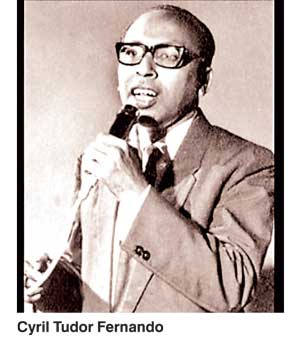Saturday Jan 03, 2026
Saturday Jan 03, 2026
Saturday, 30 January 2016 00:00 - - {{hitsCtrl.values.hits}}
 Sinhala pop was unknown then. Nor were there musical groups. The void was filled by a single man. He was CT to all of us. He was the ‘Golden Voice’ of the Sinhala song in his era – the late 1940s onwards His full name was Cyril Tudor Fernando. Had he lived he would have been 95 this week (he was born on 28 January 1921.)
Sinhala pop was unknown then. Nor were there musical groups. The void was filled by a single man. He was CT to all of us. He was the ‘Golden Voice’ of the Sinhala song in his era – the late 1940s onwards His full name was Cyril Tudor Fernando. Had he lived he would have been 95 this week (he was born on 28 January 1921.)
CT was the most sought-after singer for musical shows, for parties, for get-togethers. His songs had the rhythm and the beat for the youngsters to enjoy. He performed at the top Colombo hotels – the first Sinhala singer to be invited for weekend dances.
CT had his own style. His songs were so close to one’s heart. The words were simple, easy to remember. The tunes could be picked up instantly. That’s why his songs are so popular to this day. We oldies still remember the words to join in a sing-song.
It was the era when Ananda Samarakoon and Sunil Santha were looking for a path to create an indigenous musical tradition. CT himself was a pioneer in creating a new trend with a Western bias and catchy tunes. Two big names in the music scene – B.S. Perera and Patrick Denipitya – composed music for CT’s songs. Incidentally, CT was the first Sinhala artiste to do a musical tour in Europe with Patrick Denipitiya in 1967.
Often CT sent out a message or a fervent appeal. ‘Pinsiduvanne ane bala lamunne’, for example, was a request to children not to break birds’ nests. He presented it as a plea from a mother bird. In fact, this song, written by R.N.H. Perera, became an instant hit when sung over Radio Ceylon when CT was virtually unknown.
Motherly love is highlighted in ‘Sandavata ran tharu kekuliu pipeva’,’Ma bala kale ammage ukule’, ‘Bilinda nelawe ukule’ and ‘Badagini vela’.
‘Amabilmame oba mokada karanne’ is a chat with the moon. The well-known lines from a ‘sivupadaya’ – traditional verse – ‘Thanadale denna depole dakkanava’ is the prelude to ‘Barabage’ vividly describing the bullock cart era when they were the only means to transport goods .In ‘Mage sudu mame’ he pleads with the toddy tapper for a drink.
Romantic themes are covered in the most intimate and cultured way in ‘Ambaruk sevenalle’, ‘Sihina lowe sihina mevu mali’, ‘Ma sukumalee’, ‘Suwanda ros mal’,’Kimada surathaliye’
Patriotic themes coupled with the beauty of nature are hard in ‘Hela jathika abhimane’ ‘Kalu mahaweli kelanida walawe –sihilala maha ganga’, ‘Lo ada ninde me re yame’ and ‘Sigiri sukumaliye’.
He gives a pastoral touch in Dilindu pele gammane besa yana dola aine’ and ‘Onchilli chili chllamale’.
Among the duets, the most popular was the one he sang with Rukmani Devi, the ‘nightingale of the day’, ‘Punsanda hinehenne, vana mal pipidenne’, a dialogue between a boy and girl in a rural setting. Singing ‘Selalaihni kovyl handa’ took us round the zoo with Lata Walpola.
This is just a random selection to illustrate the wide coverage of the themes of CT’s songs. The highlight was their simplicity. Among those who wrote the lyrics were Karunaratne Abeysekera, Lalith S. Maitripala and Sarath Wimalaweera – household names in that era heard over the radio.
Born at Kadalana in the musical town, Moratuwa, CT took an interest in drama during his school days. He joined the church choir as the first step in his musical career. When he was around 30, his songs were recorded under the HMV (His Master’s Voice’), Columbia labels. The records were in much demand and when the radio started broadcasting songs from the records, they became very popular. He was soon to be selected as an A Grade radio artiste.
CT acted in several films too. He was the ‘magul kapuwa’ in ‘Gamperaliya’.
His untimely death on 17 October 1977 saw the departure of a musician much loved by the young and old alike.
Sitar maestro Pradeep Ratnayake paid tribute to CT by presenting ‘Mee amba vanaye’ – a CD with 18 CT melodies on the sitar. Pradeep echoed the sentiments of music lovers when he introduced C T as a musician who has a place in the hearts and minds of many Sri Lankans whose memories his songs continue to live. They touch hearts with their simplicity and have become a precious part of our musical heritage. How true!